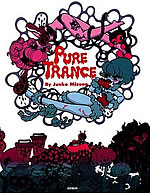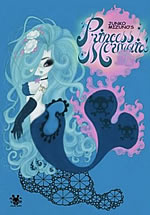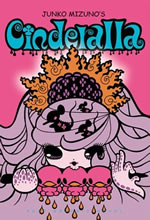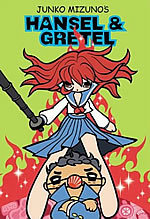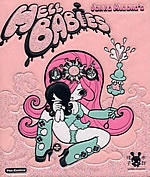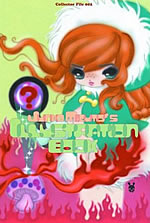Junko Mizuno:
Queen Of The Cute & Creepy
Take one look at the little cartoon character that Junko Mizuno usually draws as part of her signature and you’ll get a good idea about her work and her worldview. She sketches a sweet little bunny head with a skull’s empty eyes above a pair of pirate-style crossbones. What could be a better symbol of her unique blend of the ‘kawaii’ or cute with the creepy, of childish charm with menacing evil.

There is no mistaking her distinctive graphics, described as ‘Powerpuff Girls on acid’, available in books of her manga and illustrations, and spreading into designs for startling plastic figures and stuffed toys, T-shirts, CD sleeves, night-club decor, stationery, drinks coasters. You may have also watched her title graphics for Jonathan Ross’ Japanorama TV show some years back.
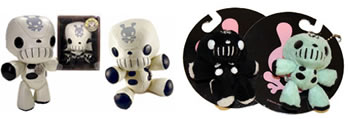
If anything, Junko’s fame is now growing stronger abroad than inside Japan as she travels to meet her fans at conventions and events. I first met Junko last January when she was a star guest at the Angoulême Festival in France, the ‘Cannes’ of comics held every year at the end of January, and the biggest festival of its kind in the world, outside of Japan. I found Junko to be really friendly, bright, petite, full of energy, and able to speak English very well with a slight American accent - "That’s because most of my English-speaking friends are from America." Later in the summer, Junko also went on a signing tour to America, including the major American convention in San Diego. So when I heard she was coming on a mini-European tour to London, Malmš in Sweden and Copenhagen in late October, I jumped at the chance to join her.
Junko flew in to London from New York, where she had been invited to take part in The Pony Project with such leading female artists as photographer Annie Leibovitz and fashion designer Betsey Johnson. Junko was there for the opening night of this wacky 5-day exhibition at Milk Gallery inspired by every little girl’s favourite toy, My Little Pony from Hasbro. "My Little Pony is not so popular in Japan because Japanese people don’t find ponies to be cute, because they can’t keep them, there is not enough space. But I found the toy when I was 18 or 19 and thought the long-haired, colourful pony was very weird and started collecting them. Every artist was provided with a huge, blank, white pony for them to customise. I made mine into ‘Witch Pony’ wearing a black hooded cape."
Junko’s first stop in London was the grand finale of IMAF, the International Manga and Anime Festival, at County Hall, where she spoke with me and a packed audience, many of whom were young aspiring manga creators themselves. Like them, I was curious how she got started. "I started drawing when I was 3. I used to make a magazine by myself with cartoons, some advertisements, recipes and other features. I still do this in my books and put in extras like stickers, paper dolls and postcards."
Growing up in the Seventies, girls in Japan tended to read one of the two hugely popular manga magazines for girls, either Ribon or Nakayoshi. "Ribon was my favourite. I entered one of their competitions, when I was about 10. Many artists are found that way. I did not win but I got a letter from the editor, encouraging me to keep going. Actually, I think they send that letter to everybody who enters! I wanted so much to be a professional at the age of 15, because there were some shojo manga artists who debuted as young as that, so I thought I had to do that too. I entered a second time, but I only got the same response - ‘Keep going’, so I gave up wanting to be a professional manga-ka at that time. I was rushing too much. So for the next seven years or so I only made illustrations."
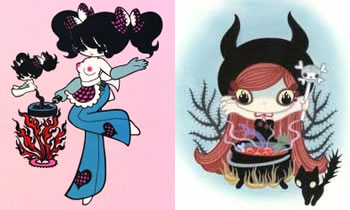
Ever since she was young, Junko’s tastes have always leaned towards the darker side. "When I was a kid, I didn’t have much money, so I used to borrow books from the school library. My favourite was a picture book of tales from Germany. It was very dark, other kids didn’t like it all, so I kept borrowing it. I couldn’t sympathise with happy, schoolgirl love stories. I preferred Kazuo Umezu’s short horror comics for girls, they really scared me. I think he is an genius. I also love horror films. My favourite is Chucky - and his bride too! I haven’t seen Japanese horror films like The Ring. I want something funny and they are too serious."
In stark contrast, what brought Junko back to creating comics again was a revolutionary anime movie that she saw while working part-time at a cinema. "I quit drawing story manga when I was 12 but started again after I saw Sailor Moon. That was the inspiration to go back to manga and completely change my style so it became more fun for me. I loved these cute and powerful girl characters. They weren’t just drawings, they had personalities and a strong story and people became so attached to them."
Another way manga artists can get discovered by publishers is by producing their own comics or dojinshi (literally ‘same people magazine’). Junko made a few, one of them based on Sailor Moon, but she never took them to the massive marketplaces like Comiket. "What I was making wasn’t like the other regular dojinshi because usually they are by fans who form groups or circles. But I was bad at making friends. I was doing mine solo and making original stories, not parodies. Instead, I got involved with some friends who started running a store called 6% Doki Doki in Harajuku selling fashion, toys and accessories for young college kids and I helped them paint the walls. Then in 1996 I asked them to sell my dojinshi called MINA animal DX, which I sold for 300 yen, very cheap. I made only one issue, photocopied in black and white, maybe 50 copies."
Still, mighty things can grow even from this smallest of ‘acorns’. "Editors from the magazines Popeye and H came to the store to do a report. They found my comics and asked me to draw something for them, only two pages, but in glossy, top-selling newsstand magazines. I think I was very lucky. From there, people noticed me and I got more and more offers."
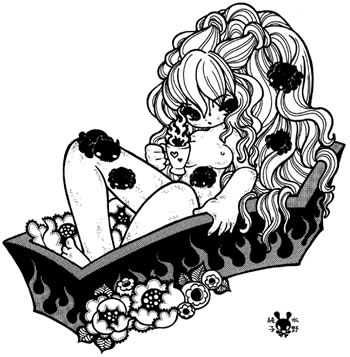
One offer came from record label Avex Trax. "They asked me to write a manga to appear with a series of CD compilations called Pure Trance that were introducing techno music to Japan. He wanted something like techno itself, a mixture of futuristic and primitive things. It was serialised in ten parts and became my first full-length story. Because the pages were for CDs, they were square and the art was quite small, so I totally redrew them in 1998 when they were made into a tankobon." This ravishingly surreal 192-page debut, recently translated into English (published by Last Gasp), is set in a bizarre post-nuclear underworld, where eating meat is illegal and food in such short supply that the survivors have to chew life-sustaining Pure Trance capsules instead. "I was also very influenced by Akira at the time. The idea of the capsules they take comes from that image in Akira." But these capsules have side-effects which cause people to seriously overeat, ending up in the ‘Overeaters Treatment Centre’. Here, patients and nurses, both real and artificial, are victimised by its selfish dominatrix director, Keiko Yamazaki. Believe me, you have never seen a horror-SF-magical hospital drama like this before!
While wrapping up her conversation at IMAF, Junko sketched one of her hell-baby heroines and then signed autographs for her fans for nearly an hour. Afterwards, for her first night in London, she joined me and other friends for drinks and dinner before heading off to her ‘home-stay’ with her hosts Ruta and Jason Atomic. Jason paints striking psychedlic portraits, including one of Junko herself.
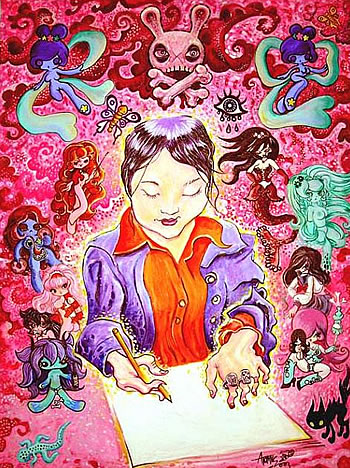
Over the course of her European trip, Junko insisted on finding time to draw. "I am working on a new big book of illustrations called Fantarama, and I am late with it! I also have regular jobs, like a small comic for a gossip magazine about idols and pop stars, and my horoscope cartoons for Viz’s Shojo Beat." Taking a complete holiday isn’t easy for a busy manga-ka.
Still, the next day, even riding her first double-decker bus was fun, as was a visit to spooky Highgate Cemetery. Wednesday evening brought her to the Institute of Contemporary Arts or ICA for a discussion with other graphic novelists from the UK, US, France and Italy. She told a capacity crowd more about her breakthrough colour book Cinderalla (yes, it is spelled that way). "My manager at that time had a friend who was a graphic designer and another who was an editor, and they wanted to make money using me. I really didn’t like them, they were very narrow-minded, but I had no other jobs, so I decided to work for them. They assumed I have no talent to make stories of my own. European fariytales were popular in Japan and I knew them from childhood and thought they were very frightening. So they told me ‘Take a well-known story, like Cinderella’. But my version is so different." It certainly is, with her zombie pop star as Prince Charming, and her Cinderalla, a yakitori restaurant waitress, who leaves behind one of her eyeballs rather than a glass slipper, though eventually they do ‘live happily ever after’. "This story was not serialised, it came out straightaway as a book, a lot of work, and was quite successful."
Two more fractured fairytales followed, continuing on a food-related theme. In Hansel and Gretel, the heroine becomes a sailor-suited samurai schoolgirl, Gretel Sakazaki, who has to rescue her kidnapped parents from a sinister Foodland where a wicked witch fattens people up by tricking them into eating dirt. In Princess Mermaid, three mermaid sisters devour the sailors they lure into their aquatic bordello, in revenge for the humans’ cruelties to their mother, until one of the trio, Julie, falls hopelessly in love with a sulky seaman, even if it means having to become human herself.
Junko was very involved with the English versions of this trilogy from Viz. "When Cinderalla first came out in Japan, I did not have a computer so I had the designer colour it. But he didn’t listen to me and I did not like the colour. So I re-did all the colouring for the US version and adapting the reading direction to left to right. I really wanted soft colours and pulp paper, to get the feel of a cheap American comic, something different from the Japanese colours and paper, which were too bright and white." Asked if she plans to do more fairytales, Junko replied, "It’s not a fairytale, but maybe when I’m 50 or 60, I want to do Anne of Green Gables." Now that should be an amazing version!
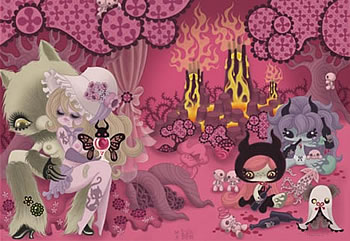
The rest of Junko’s London stay was divided between her signings, at the ICA and Thursday night at the comic shop Gosh!, her daily drawing and work, and some sight-seeing treats: a visit to the Bethnal Green Museum of Childhood with its magical antique toys; an evening at Soho’s refurbished Raymond Revue Bar; and an Indian summer stroll feeding ducks in the park. By Friday afternoon, she was all set to fly to Malmš for their Manga Festival, but due to tube delays missed the only plane. Luckily, she caught the next one out early on Saturday in time for her public appearance. Sweden is going manga-crazy too and Junko met and made many more fans there. After the festival weekend, she could relax, draw some more, and enjoy a late-night Halloween gathering, shopping for cool books (illustrator Hans Arnold and 1970s girls’ Christmas diaries) and toys (she chose the karate-chopping Roxxi from the Bratz doll range), and getting to know some of Sweden’s rising stars of manga like Asa Ekstršm and Liv Lingborn. And before we knew it, it was time for Junko and me to part, as I flew back to London and she took the train across the new bridge to Copenhagen, half an hour away, for J-PopCon and another rapturous reception.
Junko’s work combines the retro style, inspired by Osamu Tezuka and Leiji Matsumoto, and the traditions of cute shojo manga with her quirky, sometimes extreme flights of the imagination. She gave me the third and final volume of her latest epic about Pelu, a pale green, puffy-cheeked critter in a bowtie, and his quest for love in a cruel world for the monthly Comic Beam (Enterbrain). From what she told me, this story sounds more wonderfully bizarre than ever - let’s hope it appears in English soon. As she says, "I like showing both cute things and horrible together at the same time, just like in reality, where you can have innocence and ultra-violence. But I’m not trying to do this, it’s not forced, this is natural and true for me. It’s funny, underground comics are very looked down upon in Japan, but I think I am now becoming more respected in the US and elsewhere." Her latest travels to New York, London, Malmš and Copenhagen prove this. Junko Mizuno is a quietly determined, one-of-a-kind visionary, whose global acclaim is only beginning.
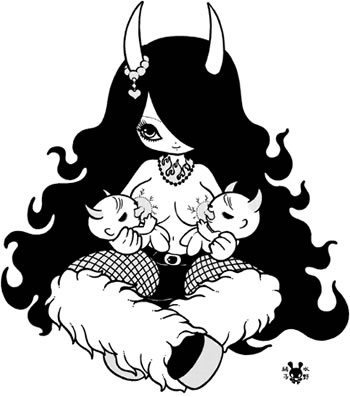
JUNKO MIZUNO BIBLIOGRAPHY:
Manga Books in Japanese:
1996: MINA animal DX (self-published dojinshi)
1998: Pure Trance (East Press, Tokyo)
1999: Cinderalla (Koushinsya, Tokyo)
2000: Hansel & Gretel (Koushinsya, Tokyo)
2002: Princess Mermaid (Bunkasha, Tokyo)
2003-5: Pelu Vols 1-3 (Enterbrain, Tokyo)
Manga Books in English:
2002: Cinderalla (Viz)
2003: Hansel & Gretel (Viz)
2004: Princess Mermaid (Viz)
2005: Pure Trance (Last Gasp and JaPress)
Illustration Books:
2001: Hell Babies (Editions Treville)
2003: Collector File 002 (Viz Media)
The original version of this article appeared in 2005 in the pages of Neo, the UK magazine of Manga, Anime, Asian Films, Games & more.













